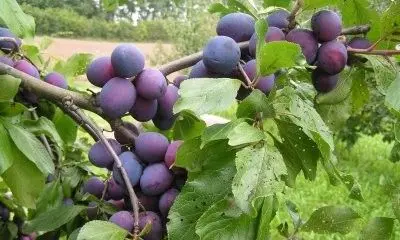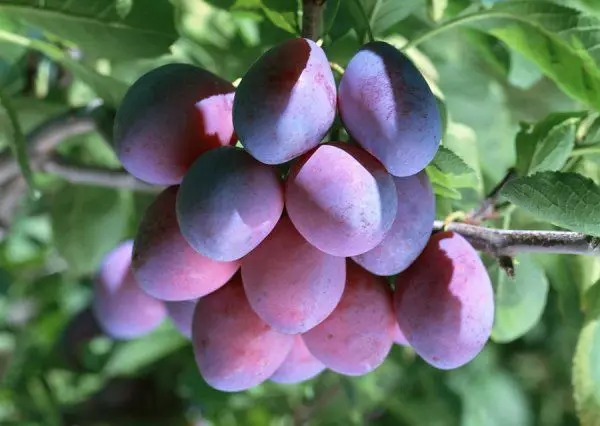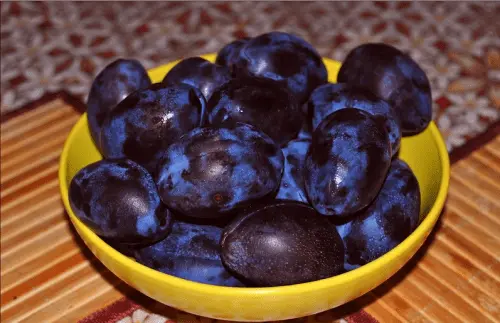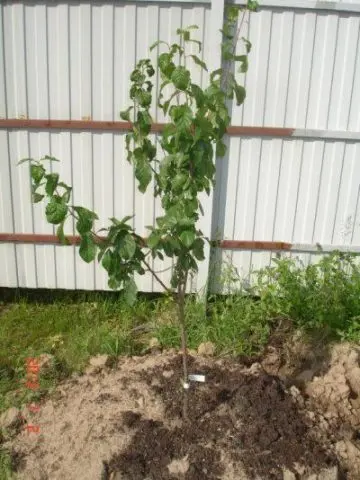Contents
Nika plum is a universal variety common in the northern and southern regions. The variety has a number of undeniable advantages. They made it popular among summer residents, commercial gardeners. An unpretentious plant in care will please with a quick, plentiful harvest. Plum fruits are a delicious summer dessert.
History of breeding
Plum Nika is the result of test work with hybrid forms. Selective experiments were carried out by Voronchikhina A. at the Rososha zonal experimental station. The plum was added to the State Register in 1994.

Description of Nika plum variety
The variety is now distributed in several areas:
- north of Rostov;
- south of Belgorodskaya;
- south of Voronezh.
Plum is characterized by average growth – up to 3 m. An adult plant after 15 years of life can reach 4 m. The rough bark is dark gray. Plum shoots change color: pinkish-brown in the sun, dark green in the shade.
Wide oval crown of medium density. Green leaves with deep veins in length from 6 to 10 cm. Medium-sized flowers turn into rather large oval-shaped fruits. Their weight is from 30 to 40 g. When ripe, the plum skin is light green. Ripe fruits are dark purple. Their flesh is a rich yellow color. The overripe fruit becomes very juicy, soft. The taste of plums is sweet, with a slight sourness and a slight hint of astringency.

Characteristics of a variety
This variety has distinctive features that determine the nuances of planting, caring for the plant. The abundance of the harvest, the health of the planting depend on taking into account the personal characteristics of the Nika plum variety.
Drought resistance, frost resistance
The plum tree tolerates drought and frost without prejudice to itself. The Nika variety withstands the hot season, taking into account regular abundant soil moisture. Resistance to significant temperature changes allows planting a plant in the northern regions of the country.
Nika plum pollinators
Variety Nika is self-fertile.
Plum blossoms in the middle of the warm period. For a bountiful harvest, the plant needs good weather during this period. Poor climatic conditions prevent the flight of insects and high-quality pollination. The fruits ripen by August.
yield, fruiting
Five to six years after planting, the plum tree will produce its first crop. It is characterized by high precocity. From one tree you can collect up to 35 kg of fruit. With proper care, good pollination, the yield can be doubled.
Scope of berries
Most often, Nika plum fruits are consumed fresh. An excellent option for the use of fruits – jams, jams. In compotes, the fruit becomes sour.

Resistance to diseases, pests
One of the advantages of the Nika variety is its high resistance to all types of diseases. Throughout history, scientists have not recorded cases of mass damage by known diseases and pests. Prevent their occurrence, development of timely methods of prevention.
Advantages and disadvantages of the variety
The advantages of plum distinguish it in comparison with other horticultural crops:
- Frost resistance Can be planted in the northern regions. Temperature fluctuations will not harm the plant.
- Abundant harvest. The plum bears many fruits in one season. Under favorable conditions, good care, the number of fruits from one tree can be doubled.
- Unpretentiousness. The variety will not require large time, material costs.
A specific feature of the Nika plum is the instability of the crop. Under adverse climatic conditions, pollination will be worse – the number of fruits is significantly reduced. The situation can be easily corrected by pollinating varieties planted in the neighborhood.
Features of landing
Plum Nika is planted in the garden for several decades. Planting a tree is a responsible undertaking. It is important to take into account the characteristics of the variety, choose the right place, soil. Subject to all recommendations, the plant will please with rapid growth, a plentiful harvest.
Recommended dates
The best time to plant is spring. During the warm season, the young plant will have time to take root, get used to the climate, the place of planting. If the seedlings are purchased in the fall, then for the winter period they should be dug into the ground, carefully covered.
Choosing the right place
Plum Nika prefers sunny places, protected from drafts and winds. The soil for planting should be moisture-intensive. It is worth checking the level of groundwater. They should not be higher than 2m to the seedling hole.
What crops can and cannot be planted nearby
Pollinating varieties are located near Nika plum. They have a positive effect on productivity. Good neighbors for this variety will be apple trees, shrubs. Tall plants with spreading crowns will give shade. This will negatively affect the growth and development of plums. Such a neighborhood should be avoided.
Selection and preparation of planting material
Planting material for planting Nika seedlings must be prepared in advance:
- Shovel for holes.
- Loosening device.
- Fertilizer.
- Stake for fixing the handle.
- Elastic rope for garter plants.
- Water.
Landing algorithm
Planting a Nika plum is a labor-intensive process. There are several required steps:
- Pit preparation. Holes for seedlings are formed in a few weeks or in the fall. Depth – from 45 to 50 cm, diameter – from 60 to 70 cm. If several cuttings are planned to be planted, then the pits for them are placed at a distance of at least 3 m from each other.
- Soil work. The fertile soil layer from the holes is mixed with fertilizers.
- Plant fixation. A stake is driven into the center of the hole. The seedling is lowered into the hole. Its roots should be at a distance of 5 cm from the bottom. Sprinkle the plum with prepared soil, tamp. The plant is tied to a peg with a soft rope.
- Watering. For the first watering, two or three buckets of clean water are enough.
- Soil mulching.

Plum Aftercare
Caring for a young plant after planting is an important process. There are various recommendations for watering, fertilizing, pruning plums. Tips from experienced gardeners are easy to follow:
- Watering. Plum Nika is a moisture-loving variety. It will tolerate drought well, provided it is moistened in time. June, July, the end of September are favorable months for watering with “under the root” equipment.
- Fertilizer. Plum prefers magnesium top dressing. It should be introduced during the autumn digging of the garden. In the spring, planting is fertilized with nitrogen preparations.
- Pruning. To form the crown, numerous young shoots are shortened, which appear on the tree 2-3 years after planting.
- Fight against diseases, pests. To prevent the adverse effects of diseases, special means for spraying the plant should be used.
- Preparation for winter. Before the onset of cold weather, the tree trunk is covered with burlap.
Diseases and pests, methods of control and prevention
Disease / wrecker | Method struggle | Prevention |
Moniliasis | Spraying a tree with Bordeaux liquid | Timely pruning of branches, removal of weeds. Affected shoots are subject to immediate destruction. |
Plum moth | The use of special pheromone traps. They lure insects, saving the plum from their harmful influence. | Regular insecticidal spraying. During the warm season, it is held at least twice. In May – the first processing. 30 days before harvest – the second |
Conclusion
Plum Nika is an excellent fruit tree for the site. The variety will please with a plentiful harvest of juicy sweet berries. The easy care process is one of the main advantages of this variety. Plum can grow in a variety of climates. Due to this, it is common in garden plots of the southern, northern regions.









